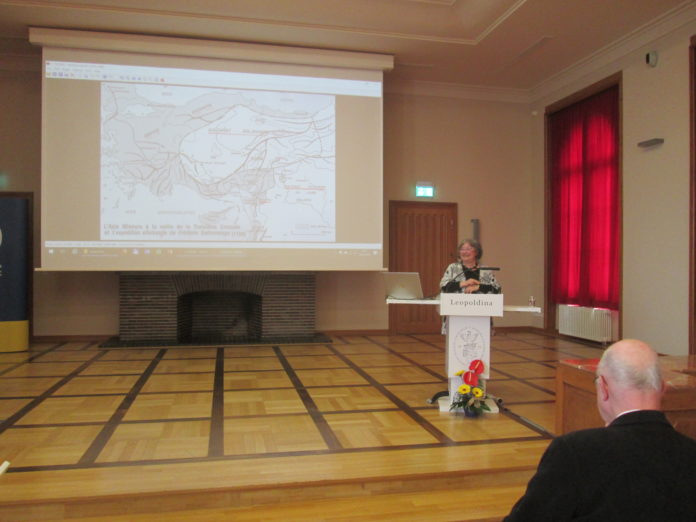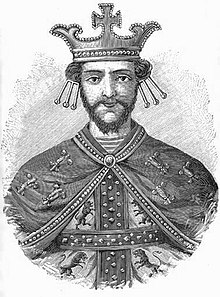Levon I and the Kingdom of Cilicia
Jun/03/2019 Archived in:Culture

Prof. Drost-Abgarjan at the conference
by Muriel Mirak-Weissbach
HALLE, Germany, May 30, 2019 — Eight hundred years ago Levon I, a king who left an indelible mark on Armenian history and culture, with respect to relations with other powers, temporal and religious, died. The German city of Halle marked the anniversary with a series of special events, coinciding with the 20th anniversary of the cultural agreement signed between the Federal Republic of Germany and the Republic of Armenia. On May 17, a cabinet exhibition opened at the Moritzburg state museum, titled, “Levon I (1187-1219): An Armenian King in the Hohenstaufen Crusader States,” followed by a festive concert by guitarists Stepan Galantryan and Emil Georgiev, a “Voyage of Songs through the Mediterranean Coasts.”
The following day, an international scientific conference took place, organized by the Mesrop Center for Armenian Studies at the Martin Luther University in Halle-Wittenberg, which is also celebrating its 20th anniversary. (https://mirrorspectator.com/2018/11/08/two-decades-of-armenian-studies-in-germany/)
Titled “The Armenian Kingdom on the Mediterranean: Cilicia in the International, Cultural and Political Context (On the Occasion of the 800th Anniversary of the Death of Levon I),” it brought together prominent scholars from the U.S., Armenia and France in the Leopoldina National Academy of Sciences. Greetings were delivered by the academy’s Vice President Prof. Gunnar Berg, Director of the Institute for Oriental Studies Prof. Cornelia Horn and Armenian Ambassador Ashot Smbatyan. A message was received from Aram I, Catholicos of the Great House of Cilicia, and Dr. Stefan Moeller read greetings from P. Frank Bayard, Grand Master of the Teutonic Order, an order established in the 12th century in the Holy Land.

King Levon I
Diplomacy, Foreign Policy and Church Relations
It was the political side of Levon I’s activities that occupied the opening session, introduced by Mesrop Center director Prof. Armenuhi Drost-Abgarjan. Claude Mutafian (Paris) presented Levon the Great as “a brilliant diplomat.” Finding himself at the head of the Rubenid dynasty in Cilicia, which was sought after by both the Christian and Muslim neighbor states, he deemed the best means of consolidating his position would be through the establishment of a kingdom, one recognized by the surrounding powers. In pursuit of this, he turned to Henry VI Hohenstaufen and on January 6, 1198 in Tarsus, under the aegis of the Holy Roman Empire, was crowned King Levon I of Armenia. The Byzantine emperor recognized him but before he could gain comparable status from the Papacy in Rome, he had to settle the controversial issue of the alleged schismatic character of the Armenian church and its autocephalic character. This Levon I succeeded in doing, by organizing his clergy to accept papal conditions in word only, and the union of the churches became a fact. In an effort to subdue hostilities in Antioch and the Hethum dynasty, he tried his hand at matchmaking diplomacy, but was not always crowned by success.
Azat Bozoyan (Yerevan) examined the direction of Levon’s multifaceted foreign policy vis-a-vis European powers as well as the Crusader states, through which he hoped to protect Cilicia’s independence. In his church policy with Rome, he acted in accord with the Catholicos, whose See however lay outside Cilicia. From 1193 on, he sought to set up a state order along the model of the Byzantine system, whereby Cilician royal power would be based on the spiritual structures of the Armenian church, which at the end of the 12th century stretched from Greater Armenia to the Balkans and Egypt. Bozoyan pointed to the coins and royal seals issued in 1998 as proof of this; here Levon is “King of Armenia,” “By the Grace of God,” “King of all Armenians” and “Dei et romani imperii gracia rex Armenie.”
Liana Aghabekyan (Yerevan) narrowed the focus to relations between the Holy Roman Empire and the Armenian Principality of Cilicia in the 1180s, when diplomatic relations were established between the Hohenstaufens and the Rubenids. Political interests motivating both sides to forge such ties included the Hohenstaufens’ desire to expand their power in the region and the Armenian principality’s ability to function as a political and cultural bridge between western and eastern Christian regions. With a western crown, Levon could strengthen his power in the Crusader states region, and he hoped to create a unified Armenian-Antiochene political system. Good relations between the Hohenstaufens and Rubenids would strengthen both in relation to the Byzantine Empire. Thus the importance of Levon’s being coronated King of Armenia, in the name of the Holy Roman Empire in 1198.
Coining the Image of the King
Before visiting the nearby museum to wander through the exhibition of selected coins honoring the Armenian king, participants heard papers dealing with the scientific approach to the matter. Ruben Vardanyan (Yerevan) spoke on “Cilician-Armenian Numismatics: Questions, Solutions, Perspectives and Limits.” In 2008 a systematic research project got underway to classify and catalogue all the silver and copper coins from the Armenian Kingdom of Cilicia – about 4500! – that are housed in the Historical Museum of Armenia. Of the planned five volumes, the first (bilingual, Armenian and English) appeared in 2014 and the last in 2017. Numerous questions arose in the course of the work, for example, regarding classification and placement, which opened up further research into the history of mintage in Cilicia. Careful study of iconographical and stylistic changes is required to clarify the identity of coins from the 13th and early 14th centuries, even those bearing the names of Levon and Hethum. One major problem, Vardanyan said, derives from the lack of reliable information on the finds and treasures, despite the huge number of specimens unearthed. The problem lies in the lack of systematic archaeological excavations in the Armenian sites there, and the destructive treasure hunting that has been taking place in recent decades.
Stefan Moeller (Halle) spoke on Levon I’s coinage reform, which he termed a “Numismatic Great Project.” The new coinage introduced by the king bears witness to the meteoric rise of the Rubenid dynasty, he said, as such large-scale reforms were quite unusual at the time. In the period of the principality (1095-1198) the five basic coins in use were made of copper sheet metal. Already in this period, the use of the Armenian language in Armenian script is noteworthy, as well as the depiction of the cross as a khachkar. Following the coronation of Levon in 1198, the capital was relocated to Sis and a new mint was inaugurated, a sign of “this new sovereign pride.” In the first emission phase, the first coins depicting Levon as king appeared with the head of the ruler, stylized, on one side, and a cross on the other side. The second phase was marked by the introduction of silver coins of high nominal value. Here the king’s face is shown in a majestic pose, and he is identified as “Levon, King of each and every Armenian, by the grace of God.” On the reverse side is a crowned “Agnus Deo Lion holding the banner of the cross.”
The very first series of coins bearing the Armenian language, according to Roy Arakelian (Paris), are those from Lori in the 11th century. The coins show Christ, with robe and halo, holding a bible, with “Jesus Christus” on both sides, as well as, on the reverse side, “Lord, help Kiurike, the Kuropalat” (a Byzantine title). Arakelian’s research has led him to conclude that the person in question was Kiurike II (1048-1100), king of Lori, who, after making peace with Sultan Alp Aslan, issued coins during his long reign. Although his immediate successors did not carry on this practice, Arakelian sees the real successors to Kiurike II in the barons of Armenian Cilicia.
Turning to the relations of the Armenians to the Latin world, Maxime Yevadian (Lyon) examined 11th-century source material and the image of Armenians it offers. Armenia is seen as the site of sacred history, for example, as a heavenly paradise and Noah’s Ark, and several Armenian or Armenianized saints are named; there are even references to the myth of a supposed Armenian origin of the Germanic peoples. It was in the period following the destruction of the Armenian highlands in the 11th century, Yevadian noted, that Armenian pilgrims headed westward, among them saints Macarius of Gent, Simeon of Mantua and Davinus of Lucca.
Modes of Narration
Illuminated manuscripts were among the works produced in Armenian Cilicia, contributing to the rich tradition. Cornelia Horn (Halle) showed how artists working on these illuminations performed an important role in transmitting and creating non-canonical traditions. These are the apocryphal narratives, that is, accounts that expand or elaborate on stories and figures known in canonical Scripture. Examining material in the framework of New Testament apocrypha, Horn combined methodological considerations with an in-depth analysis of individual examples to demonstrate the vast array of apocryphal traditions reflected in manuscript illuminations from Armenian Cilicia. The presentation located these examples within the broader history of Armenian illuminated manuscripts, identifying these as among the earliest examples.
Historiography, too, may reveal “non-canonical” material, may expand and elaborate on known events. Heiko Conrad (Frankfurt/Main) discussed how written historical accounts may reveal political attitudes. The case in point is the History of the Armenians by Kirakos Gandzaketsi (1200-1271) and his rather extensive treatment of the coronation of Levon I. Although King Levon wins praise for his courage and military successes, in this account his role in negotiations with papal representatives is ambiguous; there are nuances of censure regarding Levon’s intervention into church affairs. At the same time, certain facts touching on clerical affairs are obscured in the work, for example, the coronation itself and the council of Sis.
At the conclusion of an extraordinarily rich conference, participants were invited on a guided tour of the cabinet exhibition, which will continue until July 29. Later the same exhibition will be on display in Armenia.

